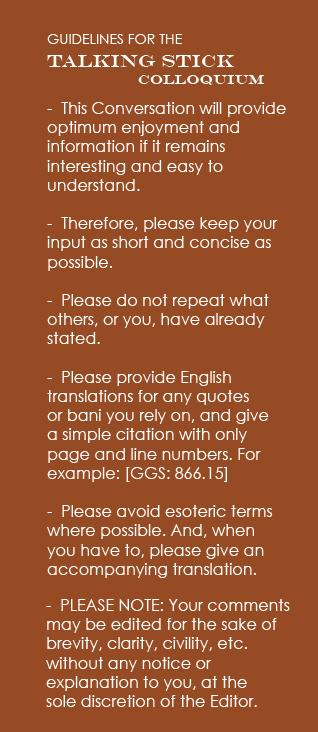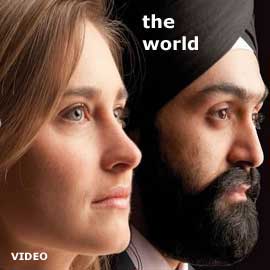Columnists
Kirtan Sohila
The Talking Stick Colloquium XXII, Stanza Two,
May 31 - June 6
Convenor: RAVINDER SINGH TANEJA
The Dialogue - so far
Guru Nanak's ability to capture our existential angst (fear) and show us the way out is no doubt testimony to his mystical insight as Guru. But to pack the message in under a hundred words and deliver it in metaphorical poetry of the most sublime beauty - that speaks to the Guru's genius. We saw evidence of this in the first shabad of Sohila.
We noticed that, unlike the Japji, there is a "rahao" or pause in the shabad, that captures the central message - in this case, an instruction to sing to that fearless One as a way to overcome our fear of crossing the threshold into the unknown. The unknown should not be viewed simply as the void beyond death, but also what lies behind the randomness of daily existence.
Fear is restricting and shrinks us, making us unavailable to participate fully in life. The fear of failure (a kind of death for our haumai) freezes us in the clichés of our humdrum existence. That is why we tend to avoid change or take chances or to follow our bliss - wherever that might lead. We do not yield our established patterns of behavior, no matter how neurotic or debilitating.
The metaphor of a wedding to capture a bride's separation anxiety and anticipation of future union beautifully captures our plight. The lesson for us is to step out of our conditioning and learn to live with the unexpected, to take risks (without being reckless) and to learn to trust the One who keeps watch over us.
An important distinction - between 'sohila' and 'sohela' - showed us the importance of the meaning of individual words, the underling grammar and the context. We must, of course, exercise caution and recognize that the technicality of grammar and meaning is simply a means to an end - that of grasping the true import of the message.
THE TEXT
This week's shabad is in Raag Asa and Guru Nanak re- affirms his message: merit lies in adopting that text or scripture where praise is given to the Creator. The advice in this stanza appears to be given in the light of the bewildering array of choices that present themselves to the ordinary person. This was true then as it is now.
Six major systems of thought are generally acknowledged to comprise the spectrum of Indian philosophy and it is to these that Guru Nanak is referring. For those interested, they are listed here, with their respective founders in parenthesis:
Sankhya (Kapil), Nyaya (Gautam); Visheshak (Kannad); Mimansa (Jaimani); Yoga (Patanjali) and Vedanta (Vyas).
Which school does one follow? Guru Nanak's advice is very telling. We find no criticism of any particular school of thought; rather they are all ascribed to a single source, namely the Akal Purakh. To emphasize this point, he points to the sun as the source of different seasons and to the different units of time from a blink to 12 years as measuring the same thing.
What can we infer from the Guru's counsel?
No particular scripture (school of thought) is recommended or debunked. The emphasis is on educing qualities that are already homogenized in us, suggesting that reading one's own mind is more important than reading any scripture.
In plain English, what this means is to stay centered (affixing one's mind) and cultivating the inner virtues that we discovered during our discussion on Japji.
Note: Giving praise or singing praises simply means to cultivate the mind so that it can flower in its authentic state - not the act of singing out aloud, although doing kirtan is a recommended way to enrich the mind.
LET'S CONSIDER:
Last week, we talked about fear in all its manifestations, albeit with special focus on the fear of physical death.
This week, the suggestion is to read (i.e., understand) and train one's own mind? What does this say for Guru Nanak's message being truly universal, independent of any particular religious bias?
One interpretation of this passage suggests that the reference here is not to the six schools of thought - as conventionally believed - but to the five passions and the mind. Some light on this would be interesting.
THE TEXT - Rendered in English
Rag Asa Mahala 1
In the Raag Asa, First Nanak
Chhai ghar chhai gur chhai updes
Six systems, six teachers and six doctrines,
Gur gur eko ves anek. ||1||
But the One Guru is the Teacher behind the different faces
Baba jai ghar karte kirat hoey
O my Mind, in the text where praise is given to that One
So ghar rakh vadai toe ||1|| rahÄo.
Adopt that for yourself and earn merit thus.
Visuae chasia gharian pahran thithi vari mahu hoa
The blink of an eye, the watch, days, weeks, months and years - are but measures of Time
Suraj eko rut anek
Just as the Sun makes the different seasons
Nanak karte ke kete ves ||2||
O Nanak, the Creator is One but wears many disguises
Conversation about this article
1: Pashaura Singh (Riverside, California, U.S.A.), May 31, 2010, 1:00 PM.
The second hymn of Kirtan Sohila comes under the heading of the Asa raag that was employed by Guru Nanak for most of his compositions. It was his favorite raag, and that is why it has always been a part of early morning Sikh kirtan. Apart from the Sikh tradition the Asa raag, is now found only in the musical tradition of Afghanistan, not in the musical tradition of north India. It is from the group of 'twilight melody-types' (sandhi-prakash raags) that are earmarked for singing in yje pre-dawn or post-dusk period for maximum effect on the listeners. In the present hymn, Guru Nanak refers to the six philosophical schools of Indian tradition [Nyaya (Gautam); Visheshak (Kannad); Sankhya (Kapil); Yoga (Patanjali); Mimansa (Jaimani); and Vedanta (Vyas)] popular during his time: 'Six great traditions each with its master, six paths of doctrine and faith. Though Your forms be outnumbered there is but One Guru of gurus, Creator of all. Refrain: If you would know how to gather true greatness, merit beyond compare, seek it where others sing hymns to their Maker, there where they sing to Your praise. Seconds and minutes, the hours, days and seasons, all own the one single source. Just as they spring from the sun their creator, all that exists is from You.' The most significant point that emerges from this hymn is to accept the validity and co-existence of different religious traditions originating from the same divine source. Why should we make any negative judgment on any religious tradition? How should we approach other religious traditions in any dialogue? What should be the guiding principles of inter-religious dialogue? In fact, the presence of the bhagat bani in the Sikh scripture offers a four-point theory of religious pluralism. First, one must acknowledge at the outset that all religious traditions have gone through a process of self-definition in response to changing historical contexts. Thus, in any dialogue the dignity of the religious identities of the individual participants must be maintained. One must be able to honor a commitment as absolute for oneself while respecting different absolute commitments for others. For this reason, the quest for a universal religion and the attempt to place one religious tradition above others must be abandoned. Second, the doctrinal standpoints of different religious traditions must be maintained with mutual respect and dignity. Third, all participants must enter into a dialogue with an open attitude, one that allows not only true understanding of other traditions but also disagreements on crucial doctrinal points. Finally, the 'other' must somehow become 'one's self' in a dialogue, so that the person's life is enriched by the spiritual experience.
2: Yadwinder Singh (Pickerington, Ohio, U.S.A.), June 01, 2010, 10:30 PM.
This is the second of the three three stanzas composed by Guru Nanak in this bani. Even though we have Ten Gurus and now the Guru Granth, the message is ONE. The style of different gurus to convey the message might be different but the theme is the same. Guru Nanak is using this beutiful analogy, 'suraj aiko rut anaik' - 'though we have different seasons, there is always the same Sun'. In fact it was Guru Nanak's jote that pervaded through the bodies of all the Gurus and now manifests in the form of the Shabad Guru in Guru Granth Sahib.
3: Aryeh Leib (Israel), June 02, 2010, 6:19 AM.
Both time and space are creations of the One Creator who is above such contrived measurements and views the entirety of His/ Her creation as one. Our analytic minds break down existence into manageable parcels that we can examine and otherwise deal with. What's being asked here, if I read it correctly, is to access the intuitive mind, which comes to the fore during meditation. This provides us the necessary counterweight to the analytic mind, affording us a glimpse of the Infinite, which connects us all.
4: I.J. Singh (New York, U.S.A.), June 02, 2010, 8:14 AM.
In our compulsive drive to enter the comity of religions in interfaith dialogue, we often tend to simplify differences such that none remain evident. But there are significant issues that cannot and should not be white-washed. Guru Nanak did not pronounce all religious doctrines or practices equally valid. Not all Hindu or Muslim saints and bards were equally included in the Guru Granth; there was a process of selection. In defending to the death the right of Hindus to practice their faith in their own way, the Sikh Gurus did not provide a seal of approval for the Hindu way of life. Similarly, for the Muslim way of life. Tolerance and advocacy of freedom of religion does not translate into affirmation. No Guru ever approved of the inequities of the caste system or the Islamic (basically judeo-Christian-Islamic) doctrine of exclusivity of their path. In a telling statement 'Na hum Hindu na Musalman', the Guru Granth says it all. In many of the interfaith forums that I have seen, our Judeo-Christian-Islamic neighbors often come with that sense of the 'exclusively chosen' and that puts an insurmountable burden to mutual understanding simply because it denies an equal place at the table to all. What do we do? We ignore this elephant in the room. An honest dialogue requires an equal place at the table for all, bar none. I have taken on this issue in an earlier column, 'The Spin Cycle', on this site. Yet we all, myself included, value and need more interfaith communication and always will.
5: Nirmal Singh Nilvi (Texas, U.S.A.), June 02, 2010, 8:20 AM.
Pashaura Singh ji has beautifully captured the meaning and the essence of the message of this hymn. Guru Nanak's trade marks in composing poetry are all over the hymn. The briefest words are used to tackle the most divisive issue among humans (God, and the most critical human faculty: the human mind). The solution offered is backed with solid proof, not just a proverbial prophet-like opinion or reflection. The message is simple and clear: there is only one Him (Akal Purakh). Exiting approaches of six schools of thought, with six doctrines delivered by six different looking mendicants, are all in the pursuit of the same goal, to seek Him. Our individual challenge remains the same. Our mind has many choices, many ways, many temptations. Why not pursue the path that offers the most desirable outcome. Make Him the guiding force because it is viewed as the most praise-worthy approach in every human established custom or tradition. The human approach in establishing religious doctrines and assigning different names is no different than a similar custom of assigning different names to time, seasons or different periods, all influenced by one source: the sun. Make Akal Purakh the focus of your entity, because all religious paths lead to the same Akal Purakh. Just in seven lines, Guru Nanak has condensed the entire rigmarole of Him, religion, our mind and the need and necessity of their relationship. The entire concept, style, approach, believability are encased in just seven lines. No wonder it is motivating, universal and awe inspiring.
6: Aryeh Leib (Israel), June 02, 2010, 8:35 AM.
Inder, this is something that has bothered me to no end. How to be friends with someone (ie. Christian or Muslim) who has an agenda, overt (if honest) or covert, that requires me to convert to his religion?! An honest dialogue sounds like a hopelessly impossible dream, if the concept of "equals" is a non-starter.
7: Ravinder Singh Taneja (Westerville, Ohio, U.S.A.), June 02, 2010, 6:26 PM.
Perhaps Dr Pashuara Singh ji can comment on the selection process that Guru Arjan employed. The fact that he excluded some submissions made to him and included others would lead us to believe that doctrinal differences played a role.
8: Pashaura Singh (Riverside, California, U.S.A.), June 02, 2010, 7:26 PM.
I also had the kind of experience that I.J. Singh has narrated in his post. All religious communities make exclusive claims. In particular, a new religious movement must represent elements other than the orthodox traditions of its times. Unless it did, it would not have been called forth and could not distinguish itself. Therefore, the exclusive claims made by an emerging religious community must be contextualized as part of the process of building of self-esteem in the early experience. Psychologically, the sense of the unique superiority of one's own religious tradition may be simply a natural form of pride in, and an ingrained preference for, one's own familiar group and its ways. It is an inevitable part of life and must be taken into account in inter-religious encounters. It is only at an intuitive level, as Aryeh Leib ji has proposed, that we can be magnanimous towards people of other faiths. Guru Nanak is speaking from that spiritual height where all forms of religious expression add to the beauty and wonder of Akal Purakh's creation. The Sikh Gurus expressed their disagreements even in their comments on certain verses of the bhagat bani in the Guru Granth Sahib itself. See, for instance, the comments made by Guru Nanak, Guru Amar Das and Guru Arjan, on the specific verses of Sheikh Farid and Kabir. Nevertheless, all bhagats were allowed to have their own voice. Sheikh Farid freely expresses his Muslim beliefs and practices in the Sikh scripture. The Gurus respected their voices. Once we have confidence in our own tradition, we can give equal regard to other religious traditions. When we are not confident, we become defensive. All religious traditions are changing as a result of interfaith dialogues. The process of globalization has brought people of different faiths on the same platform. We must give equal dignity to our dialogue-partners. Otherwise there is no meaning of having such a dialogue.
9: Nirmal Singh Nilvi (Texas, U.S.A.), June 03, 2010, 1:00 AM.
Aryeh ji, your sentiments about the concept of equals are noteworthy. An honest dialogue sounds like a hopelessly impossible dream, even in the religious context. That is the irony between an ideal and reality. And we live in a real world. Scriptures do inspire us to do good; but in reality we are better known for our destructive impulses. Religion, by its character, is an emotional institution. How can we expect rational outcome from it is beyond my ability to understand. Just like "Camelot" or "Shangri La" that exist in books only, religious heaven is also in another world. We need to accept these realities and take the good in it. For the true seekers, there is plenty of good in it. About finding an equal seat at the table in a religious comity dialogue, again we have to be practical. Equality may be divine in concept, but humans implement it. Hence in the human realm, an equal seat has to be taken, never graciously given. It is only Him that may grant in grace. Any other approach to attain it is being emotional at best. The message in the Japji study was clearly against being emotional. As Pashaura ji said, there are many positive elements in the interfaith dialogue. To embrace this movement is in the best interest of all humans . And I.J Singh was gracious to say that inspite of certain questionable approaches, Sikhs will participate actively, because it is inbuilt in the Sikh tradition.
10: Ravinder Singh Taneja (Westerville, Ohio, U.S.A.), June 03, 2010, 6:06 AM.
I chanced upon the following verse and it gave me pause: "Khat darsan varte vartara/ gur ka darsan apar apara" - [GGS:360]. The six systems of philosophy are pervasive but the Guru's way is unequaled, so the passage appears to be suggesting. The six systems are the same ones we are discussing. In Sohila, the thrust appears to be that all systems derive from the source, yet in Guru Amardas' verse that I have quoted, the impression is that the Guru's way is the right one. How would we interpret these lines? Is the Guru's way the common essence of all the different philosophies? Would love to hear your thoughts.
11: Ravinder Singh Taneja (Westerville, Ohio, U.S.A.), June 03, 2010, 6:36 AM.
Funny how one begins to receive intimations when the mind is reflecting on a subject: soon after I posted my previous message on the Guru's way, I came across this passage from Ibn Al Arabi, the Sufi poet giving me a hint to Guru Nanak's underlying message. I share: "My heart has become capable of every form: it is a pasture for gazelles and a convent for Christian monks; And a temple for idols and the pilgrim's Kaaba, And the tables of the Torah and the book of the Koran. I follow the religion of Love: whatever way Love's Camel takes, that is my religion and my Faith." God for Guru Nanak is Love and it is the religion of Love that we need to practice.
12: T. Sher Singh (Mount Forest, Ontario, Canada), June 03, 2010, 8:11 AM.
Re Ravinder ji's query in comment 10 - I find that the quoted passage makes sense if we remind ourselves that 'gur' here refers to God.
13: Ravinder Singh Taneja (Westerville, Ohio, U.S.A.), June 03, 2010, 11:27 AM.
Sher ji, I quite agree. My sense is that the term Guru is used (with some exceptions) for God as Guru or Knowledge. The quote from Al Arabi I just loved because that is the crux of the whole matter: Love.
14: Mohan Singh (Toronto, Ontario, Canada.), June 03, 2010, 6:19 PM.
The second stanza presents the singularity of the Ultimate despite endless diversity of scriptures, the message 'God is One' and He is in all His creation and creatures - 'Nanak karte ke kete ves'. By singing praise of Akal Purakh, receive his grace and be fearless. Guru Amardas says: 'Gur sabday raataa sehjay maataa naam man vasaa-ay/ Nanak tin ghar sad hee sohilaa je satgur sayv samaa-ay' - 'They are imbued with the Word of the Guru's Shabad, and intoxicated with celestial peace; the Naam abides in their minds, O Nanak, the homes of their hearts are filled with happiness, forever and always; they are absorbed in serving the True Guru' - [GGS:771]. Guru Sahib further says: [GGS:772] - 'In that home, and in that heart, where the true bani of the Lord's true praises are sung, the songs of joy resound.' Ravinder ji, 'Gur ka darsan apar apara' - [GGS:360], refers to bani guru or shabad guru. Bani of Bhagats such as Kabir, Farid, Namdev, Ravidas and others was selected and collected by Guru Nanak during his Udaasis. Guru Arjan selected that of the bards, Bhai Sunder, Satta, Balwand and Bhagat Surdas, etc.
15: Nirmal Singh Nilvi (Texas, U.S.A.), June 04, 2010, 9:46 AM.
Mohan ji, enjoyed reading your post. I have a query. Using our customary "gurmat" prism, is there an opportunity to deepen or widen the essence of the message? My thought is driven by an impulse to investigate the possibility of various readers focusing on the message from different angles. For example, you from "gurmat", Pashaura ji from the mystic anddivine, myself from practical utility, etc. May be we are already doing it due to predisposed orientation of our minds. Any thoughts on the approach? Will it enhance the outcome?
16: Mohan Singh (Toronto, Ontario, Canada), June 04, 2010, 4:13 PM.
Thanks, Nirmal ji, I am neither a preacher nor a bhai, neither a scholar nor a journalist nor a writer. I am a retired person, learning and trying to understand gurbani at the Guru Granth Sahib Academy of Singh Sahib Darshan Singh from the time he started it. I have a huge collection by Maskeen ji and by Singh Sahib, I listen to them repeatedly and sometimes do comparisons and discuss with Singh Sahib when I feel it necessary. The way he explains with relevant illustrations from within gurbani, I am getting a lot out of it. He believes explaining gurbani in the light of gurmat. Another hobby is (seva) consulting homeopathy, give free services to the sangat, friends and relatives; also, discussing gurbani with them but with no intention of preaching. Learning to understand the Guru Granth Sahib from Singh Sahib is a great experience.
17: Ravinder Singh Taneja (Westerville, Ohio, U.S.A.), June 05, 2010, 7:29 AM.
Personally, I absolutely agree with Mohan Singh ji - that gurbani is best understood in the light of gurbani. This is an insight that the late Giani Gurdeep Singh ji of Richmond Hill Gurdwara shared with me ("Gurbani di viakhiya gurbani aaap kardi hai") and my own experience has confirmed this. By looking for explanations outside, we often miss the point.
18: I.J. Singh (New York, U.S.A.), June 05, 2010, 9:59 AM.
Yes, gurbani is best understood in the light of gurbani and that is an essential first step. It is not the endpoint. The next equally essential step is to apply that understanding of gurbani to the world around us and outside of us. The essence of gurbani lies in its meaning and its application. Only then are lives shaped.
19: Ravinder Singh Taneja (Westerville, Ohio, U.S.A.), June 05, 2010, 11:46 AM.
To Dr. I.J. Singh's note, I can only say what my daughter often does when I state the obvious - "Daah" - no offense intended to the Russians!
20: I.J. Singh (New York, U.S.A.), June 05, 2010, 12:17 PM.
Yep, except that the obvious often gets missed.
21: Nirmal Singh Nilvi (Texas, U.S.A.), June 05, 2010, 4:38 PM.
I could never imagine that interpreting Sohila will generate so much real heat ignited by Mohan Singh ji's befitting and wise point. All it took was for Ravinder ji to flame it to burn brightly. And I.J. Singh ji provided caring direction. Gurbani has the intensity to shape lives when we focus on learning and sharing with others whatever little bit we may have learned without forgetting we still remain Sikhs (learners). Mohan Singh ji's attitude is something to emulate in assessing the purpose of learning gurbani. Creating a pro-learning environment inspires the mind to learn and become spiritual. And letting gurbani serve its purpose: shape and nurture lives.
22: Yuktanand Singh (Saline, Michigan, U.S.A.), June 06, 2010, 3:48 AM.
I stumbled upon this discussion today. In my opinion, the motif here is: religious malice towards none. Guru Nanak says, 'Any house where there is praise of the Lord is acceptable.' The individual conduct (achaar) and intentions are important, not the religious label. The first verse says that in various schools, the true Guru is always the same. The last verse says that just as the months and seasons change but the sun is always the same, God is the same in various religions. The words, "So ghar raakh vadaa-ee to-ae" are often translated wrong. "Baba (O Waheguru!), any house where (You) the doer is praised, (You) save that house; (This is) Your Greatness." Measured with this yardstick, verses of Bhagats from opposing religions were included in the Guru Granth Sahib. But some verses are attributed to these same Bhagats but they did not meet the criteria of pure, ego-free gurbani. They were rejected.
23: Ravinder Singh Taneja (Westerville, Ohio, U.S.A.), June 06, 2010, 2:44 PM.
I am glad you stumbled upon this discussion, Yuktanand ji. Please join in. We have taken a slightly different tack in translating the line: "Baba..." above. Take a look.
24: Yuktanand Singh (Saline, Michigan, U.S.A.), June 06, 2010, 9:39 PM.
Ravinder ji: It is difficult to translate Guru Nanak's compositions. I see that this discussion ends today but we seem to have missed a proper rendition of the refrain (the "Baaba....") line in this shabad. I could be totally wrong but a shabad with only a few lines (or a couplet) is generally cohesive. Why would Guru Sahib make three separate statements in this short shabad? It appears to me that all three lines have made only one statement: God and Guru is the same in all the paths, provided that the individual on that path praises the true doer (karta). We do not judge anyone and we accept diversity. "Vadaa-ee to-ae" refers to God's greatness, not an individual's, because asserting a path's or an individual's greatness is never the aim of gurbani.
25: Pashaura Singh (Riverside, California, U.S.A.), June 06, 2010, 10:24 PM.
Yuktanand ji has raised an interesting point about the usage of the word "Baba" in this hymn. This is used in the vocative sense, in which Guru Nanak is addressing himself, "O Baba!". During his lifetime, Guru Nanak was addressed by his audience as "Baba". The Janam-sakhis employ the title "Baba" for the Guru as "Baba Nanak". There are so many hymns where Guru Nanak addresses himself as "Nanaka!" (O Nanak!) or "Nanak!" (O Nanak!) or "Baba!". These grammatical conventions become obvious if one has taken the course on the text, *Sacred Language of the Sikhs* authored by Dr. Christopher Shackle. I teach this graduate course to my doctoral students. Most of the Sikhs do not know these conventions, although they will never accept this deficiency in their learning. To be honest, Sikhs have not done any serious study of the Guru Granth Sahib. Even if we know the Punjabi language, that will not provide us with the knowledge of the grammatical conventions of the bani. I have been extremely careful in this discussion not to offend anybody. I always encourage engagement with gurbani.
26: I.J. Singh (New York, U.S.A.), June 07, 2010, 9:18 AM.
I am somewhat baffled by the comments of both Yuktanand Singh and Pashaura Singh. I wish they would briefly and precisely tell us what exactly the correct rendition would be; and secondly, how exactly would that alter and impact the meaning and substance of the line cited here. Much appreciated.
27: Yuktanand Singh (Saline, Michigan, U.S.A.), June 07, 2010, 12:41 PM.
My rendition is not necessarily a correct one and I have second thoughts already. I am not sure if another version will alter the meaning too much. It appears to me that the refrain is the reason for the preceding and subsequent statements in this short shabad and, as long as we keep this in mind, various renditions would be acceptable. I am sure we will agree that the meaning of gurbani is not static. We may notice a different nuance each time, particularly when we read certain complex verses, because Guru Nanak often makes a statement for multiple reasons. Dr. Pashaura singh ji started this topic with a well written, short and scholarly commentary on the spiritual message of this shabad. Perils of brevity! - I neglected to say that I do not disagree with the various thoughts given above. I was compelled to interject because no one had discussed the translation of the refrain. Let us be sure that all the verses have been discussed.
28: Yuktanand Singh (Saline, Michigan, U.S.A.), June 07, 2010, 2:50 PM.
Dr. Pashaura Singh ji: Sorry I missed reading your comments earlier. I appreciate your concern. Lack of training could waste plenty of time with frivolous questions. My agreement may not be important here but I agree with your general meaning of 'baba' in Gurbani. Occasionally, this word has been clearly used to address Waheguru also. For example, "Baba jis too deh soee jan paavai" [GGS:918.1]; "Aa-des baba aa-des" [GGS:417.3]; or, "Baba mai karam-heen koorhiaar" [[GGS:989.6]. In some other instances, 'baba' could be translated either way; for example, "Baba moorakh haa naa-vai bal jaa-o" [GGS:1015.15]. I respect your wisdom and scholarship and the last thing I want to do is to contradict a learned person, particularly at the cost of my lunch time! I am here to learn.




